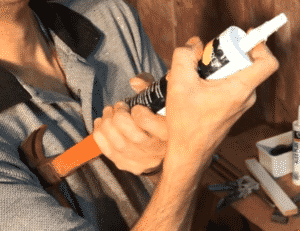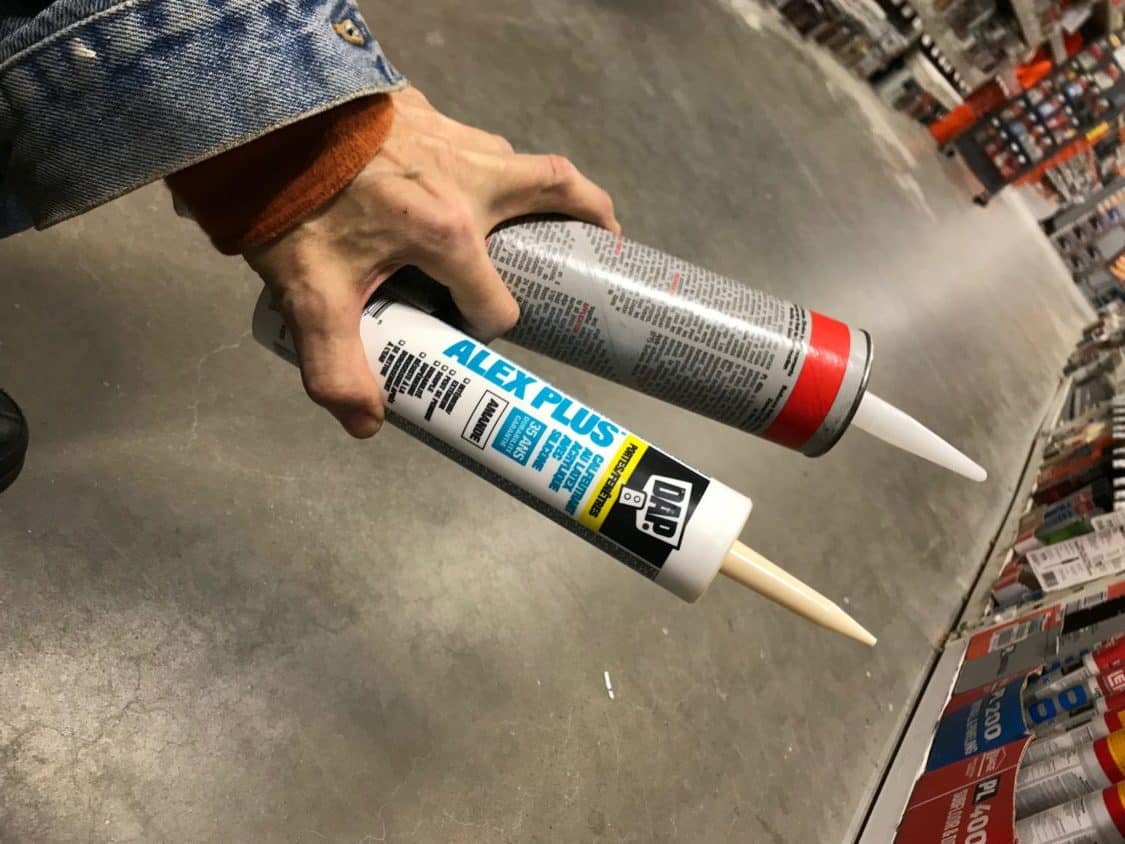We eliminated all the products that are overpriced or low-quality. So here are the professional choices-only the best caulk. Some glues below also.![]()
Top Caulk: Here is my top choice for the painter’s indoor/outdoor caulk.
Bathrooms: The best caulk containing silicon for the shower, tub, or sink comes in 2 versions: a caulk gun tube or in smaller hand-squeeze tubes. More details below.
Second, how much caulk to buy? One tube would last me 1-3 average rooms.
My best advice for the long haul: Get the best caulk that does not crack over time.
You cannot store unopened tubes for years: see our other post about how to do the caulking, how to buy the right caulk gun and how to load a caulk gun.
Tip: For a very straight line between two colors, such as the ceiling and wall, we lay a bead of caulk in the corner. We caulk all trim/wall joints needless to say.
Tip: Some people use painter’s tape to keep the bead of caulk small: that is good if you are new at this.
You also need a good caulking gun, we recommend one of those:
1. NORMAL PAINTING:
Note that caulks with silicone, even paint-able ones, take longer to dry than non-silicone. Check the specs before using outdoors: many of the best caulks are suitable for both interior and exterior.![]()
The #1, go-to product I have used all my life is here at a very good price: the painter’s indoor/outdoor caulk from DAP. Some people call all caulk “Dap”, like they call tissue “Kleenex”. That’s some branding! Ignore any bad ratings: people don’t know what they are talking about: pros use this A LOT.
My 2nd favorite is Alex Plus: it’s the same as the one above but has a longer life and more flexibility, (because it has some silicone, which therefore takes longer to dry).
Here is the white, but see the related pages for other colors: Clear, Almond, Black, Brown, Tan, Bronze, and Gray.
Just painting a small room or a few cracks? Hand squeeze tubes are the way to go:
Start here with the white DAP hand squeezer.
2. SHOWER, TUB, SINK:
If it gets wet, go the full monty: silicone caulk (our pick can be painted, but does not have to be painted). Even the best caulk made of silicon is toxic: read the warning section below!
Use the best silicone product today: paintable Gorrilla (company website). This is the very best caulk for silicone caulking applications on the market. It comes in a caulk gun tube or in hand-squeeze tubes.
For cracks beyond help, try a plastic strip. These do last. Look around for other colors if your tub is not white.
- How much to buy? One squeeze tube will do a tub if your cracks are small. Don’t use to replace the grout.
- Have a big tub or shower? You’ll need a caulk gun tube (10 to 11 ounces), or several hand-squeeze tubes.
3. BEST CAULK FOR MASONRY, METAL, ETC:
Sidewalk cracks? Save your mothers’ backs with concrete caulk: a case is a very good deal. It keeps water out of your pavement to extend lifespan.
Butyl Rubber caulk is suitable for always-wet applications – the product page talks about how to get good bonding.
Custom color: match any color: I’ve never tried it. Let me know if it works out? Thanks
More? You bet. Epoxy, rubber, resin, steel, yes, steel. It goes on and on. Very rare that you will need any of these, but…they are listed here. Any questions? I’ll try to help: I hang out in the comments below.
4. Glue comes in a tube: ba-da-boom. Genius. Since you do have a caulk gun…
I use these two: Gorrilla Construction Adhesive, yeah baby. (This is not the expanding when wet type)…and…
Dap Construction adhesive comes in a tube and is the best deal in glue.
Summary:
When I was young my first employer taught me about the best caulk. If you have any questions about how to use a caulking gun or anything else, let us know in the comments.
You also need a good caulking gun, we recommend one of those:
Silicone caulk warnings:
- You only need silicone where you splash water: most are very toxic and difficult (messy) to use, and where you have porous surfaces (it does not bond well). Use gloves, please wear a respirator: very important – the best respirator is linked in Part 7, below) and open windows.
- You usually do need to use silicone for glass, tile etc, but you should know that it is quite hard to remove after it cures.
- Let fresh silicone caulk dry overnight, 24 hours before using the shower cured and 100 percent waterproof. Even fast-drying products should be given 6-12 hours to cure before using the shower.
- Silicone caulk is very sticky and cannot be washed up with water. Use rubbing alcohol to clean up before it dries. Full rubber gloves are a good idea as it sticks to hands like glue. (Read the label: some types use paint thinner/mineral spirits to clean up.)
- Open windows and doors near the caulk you wish to cure faster and keep the area warm. You can set up fans and/or dehumidifiers too.
- There is more under Section #1: “How to use caulk gun”. Look for How to use a caulking gun in a shower?
5. Bonus: doing the job with no gun
If you are just doing this once and you don’t want to buy even the lowest priced caulk gun out there: yes, you can get by. You can buy caulks in a toothpaste type tube silicone kitchen and bath and of course painter’s acrylic caulk. So you really do not need to know how to use a caulking gun.
These small tubes are a bit more expensive for what you get, but it is a good thing to have around.
Please see my video below for what to do if your nozzle becomes clogged beyond saving: you don’t have to trash it!
Ok fun time.

How to use caulk gun you make yourself (and this is in the first of 2 videos below at 3:45). Use a T-shaped stick (such as the handle of a hammer): Put the stick into the back of the tube and just push the caulk out by pulling the tube back into your shoulder or chest! That’s how to use a caulking gun with no caulking gun!
Any questions? I read all comments below.
Video 1 of 2
How to use a caulk gun




Hi Brad,
I need to caulk around a hot tub. I have tried silicone caulk, which works for a time, however, due to the condensation, the area is always wet, and the caulk is not dissolving per se, but kind of dissolving. Is there a good caulk that would be waterproof and could withstand constant wetness?
If you can keep the area dry for the time it takes for caulk to dry, this caulk should be OK. that’s my best advice, but I cannot see that your work so I cannot guarantee I’m right.
Hi Brad,
Your website is very informative. The caulking around my exterior painted bibre glass windows and sliding doors are cracking. These windows and sliding doors intersect with either bricks or concrete floors. What would be the best caulking, expandable caulking I can use that I can paint over and will not crack? Do I need to scrap off all old caulking? The area located in the Lake Ontario region where we have sun, snow and rain during the year.
On another point, Can i use the same caulking materials to recaulk and seal my skylight windows where aluminum roofing and the fibre glass skylight meet?
Many thanks for your advice
Exterior caulk in both cases, but ask a window seller about skylights.
Yes remove loose caulk, but ok to leave if tight. Do when it’s dry out for sure.
Buy the best you can get, don’t skimp!
Check the label for ‘paintable’.
If possible, don’t paint it…get a good colour
b
Hi Brad, I just bought a home and am getting a lot of bugs. Im planning to use your rec for the best paintable caulk but do you have any suggestion on a product to use if I need to fill a gap before I caulk? An expandable foam or is there something better? I will be doing this all over my house, around windows and baseboards, to limit entry points for bugs. I have two young kids though, so if there are products better to use than others around them, I greatly appreciate it. Thanks for any help.
That foam great stuff, the brand name, is good…will ruin clothes and even eyeglasses so wear good protection
Caulk that when it dries.
I found soapy water is the best deterrent: not toxic for your lungs and they give up if you just keep it wet
This is after you caulk…they will find a way in.
Also cayenne pepper most bugs run away
Good luck.
Hi Bob, comma I have an exterior tongue groove ceiling That when installed weren’t Tightly fit . I have sanded and primed the whole ceiling And I am looking for the best Caulk to seal the gaps, I want to leave the v grooves . I plan on painting once the gaps are filled.
Thanks
Hi. Brad, not bob. Use any interior non silicon calulk. Silicon is just not needed, but not wrong either. Takes a long time to dry so we avoid when not necessary.
hi Brad,
My tongue and groove ceiling is exterior, And when it was installed Boards weren’t tightly fit, I want to fill the gaps with caulk And then paint.
Sorry for the delay.
Yes, exterior caulk, same procedure as an interior.
I have a always moving foundation which is causing cracks in the same place, corners. Foundation has been repaired and double checked this week everything is still in alignment.
Cracks were fixed and repainted less than six months ago and it has re-crack what is the best caulk to use for that?
Hi. Since I can’t see it I cannot know the real problem. It sounds like your masonry is moving with temperature changes. I don’t think caulk is the thing here. Ask a builder but I think you need to have it filled with cement.
Good luck,
Brad
What do you recommend for caulking around a metal kitchen sink?
If you want white or clear, get silicon. Make sure the surfaces are very clean!
This is a good one.
Hi Brad. I need to caulk the top of an exterior door jam, but don’t have access via a gun. I could bead the caulk and lay it in / smooth it out. The window glazing I have is too runny and too sticky. I saw a This Old House episode where the guys rolled some putty into 1/4-1/2 inch noodles and lay them in. Should I be looking for “putty” not “caulking”?
Thanks
Well I asked the gentleman to reply, but got no email. I think in most cases, we use some sort of wood or plastic backing in very wide gaps, and then caulk/putty/spackle and seal to keep the water out. The downside: nothing is forever!
Pet Peeve:
First,here is my top choice for the painter’s indoor/outdoor caulk. The best caulk containing silicon for the shower, tub, or sink comes in both a caulk gun tube or in hand-squeeze tubes. More details below.
I’m a chemist and I hate to see “silicon” used like this. Little things drive me crazy. Silicon is on the periodic table and microprocessors, not in a caulk gun.
I really don’t think that the name of the caulk matters. You are right in that the actual ingredient is silica, but all makers put silicone on the label. Like DiNiro said to Hoffman in Wag the Dog: “It’s true if it’s on TV.” We’re stuck with the word for ever and ever.
Thanks for writing.